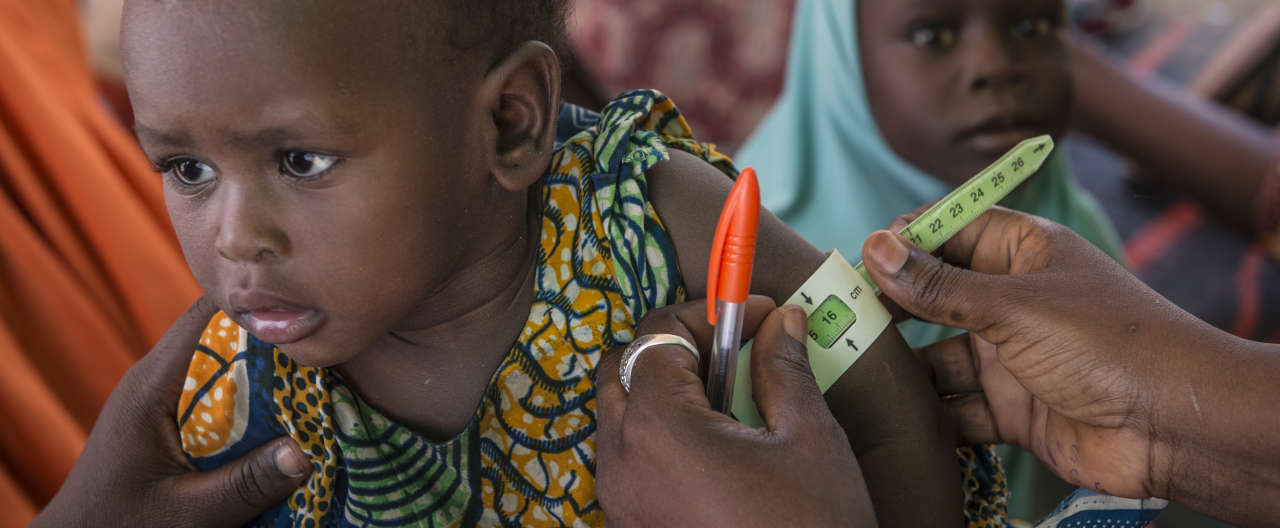what forms of technology can be used to reduce hunger and improve food security in sahel
Ending hunger
Across the world, up to 811 meg people do not have enough food. According to recent estimates, 44 million people in 38 countries are at risk of sliding into famine – the most extreme form of hunger, which can consequence in death from starvation or disease. Indeed, parts of Yemen, South Sudan and Madagascar may be close to or are already in the grip of dearth.
The consequence of diets poor in vitamins, minerals and other nutrients are affecting the health and life prospects of millions more than, and casting a shadow over the future of communities and entire countries.
Although enough food is produced to feed anybody on this planet, the goal of a world with zero hunger, as set out in the 2030 Agenda for Sustainable Evolution and specifically in Sustainable Development Goal 2, remains hugely challenging due to a toxic cocktail of disharmonize, climate change, disasters and structural poverty and inequality. Over the by year, the socio-economic consequences of the COVID-19 pandemic have further exacerbated the state of affairs by pushing millions of vulnerable people into greater food insecurity.
Hunger: causes and solutions
Hunger: causes and solutions
threescore percentage of the globe'south hungry people live in zones affected by disharmonize, which is the main driver in 8 out of 10 of the worst hunger crises (as in the case of Yemen, S Sudan, the Congo-kinshasa and Syria, for example).
What we are doing
Food and nutrition assistance
WFP brings life-saving nutrient and nutrition assistance to people trapped or displaced by fighting, wherever they are. With the aid of local partners, we reach those in need fifty-fifty in the most remote areas, using all-terrain vehicles and dropping food from planes when all other avenues are closed.
Our assist tin can help create pathways to peace, as recognized in the application of the Nobel Peace Prize to WFP in 2020.
Prospects for peace
Preliminary findings from a joint inquiry study with the Stockholm International Peace Research Establish indicated that WFP's work contributed to improving prospects for peace past enhancing admission to contested natural resource, boosting social cohesion and resolving grievances inside and between communities, while increasing opportunities and trust between people and authorities through strengthening land accountability and service delivery. The report focused on El Salvador, Republic of iraq, Kyrgyz republic and Republic of mali.
Climate change-related shocks such equally floods or drought bear upon the lives and livelihoods of millions of people, aggravating poverty, hunger and social tensions. WFP helps governments and communities to sympathise these increasing risks and to take targeted measures to manage the impact of climate shocks on nutrient security.
What nosotros are doing
Forecast-based financing
WFP's Forecast-based Financing uses improved early warning based on weather forecasts, so communities can be alerted to climate-related and other shocks xv days in advance and provided with insurance to take preparatory measures.
Climate-smart free energy solutions
To ensure people tin cook and swallow food safely, WFP facilitates access to modern cooking solutions – such as gas stoves, mini-gasifiers or electric pressure level cookers. WFP also strives to empower smallholder farmers through the sustainable dissemination of energy equipment and services for productive uses to heave agronomical marketplace development.
When an convulsion, cyclone, a hurricane or other disaster strikes, WFP is a first responder, bringing nutrient and other life-saving assistance to populations that have lost everything.
What we are doing
Logistics
Equally the leader of the inter-agency Logistics cluster, WFP provides coordination and information management in the response to big-calibration disasters.
Connectivity
WFP leads the Emergency Telecommunications Cluster, which provides life-saving connectivity in emergency situations. WFP's Fast IT and Telecommunications Emergency and Support Squad of responders (FITTEST) is ready to deploy anywhere in the world to establish and restore communications and information technology networks.
Geospatial analyses
Targeted geospatial analyses show the immediate touch of natural disasters and permit for a faster response matched to needs. Our Geographic Data Systems tools such as ADAM (Automated Disaster Analysis & Mapping) provide 24/7 mapping of earthquakes and tropical cyclones.
Inequality drives hunger by limiting people'due south opportunities and increasing levels of hunger. Increasing access to employment, finance and markets, for example, can lift people out of poverty very apace, increasing their productivity and spending ability and stimulating local markets.
What nosotros are doing
Food assist for avails
WFP'due south Nutrient Assistance for Assets programme involves people working on community projects such equally restoring unproductive country, in render for cash or nutrient. The private sector-focused Subcontract to Market place Brotherhood connects smallholders to markets and helps them diversify their crops and increase their business potential.
Cash transfers
Where markets and fiscal systems are performance, WFP provides assistance in greenbacks. Whether in the form of depository financial institution notes, vouchers, debit cards, due east-money or mobile money, cash transfers allow people to brand choices that better their food security and nutrition, and inject cash into the local economy.
Social safety nets
WFP supports governments in strengthening the social safety nets they have in identify to protect their citizens from poverty, inequality and food insecurity. We also work to enhance the ability of these systems to respond to shocks such as disasters or mass population displacements.
Poor storage facilities in farms pb to pest infestations and mould ruining crops. Lack of access to technology and markets means many farmers are forced to watch their crops rot in fields as the labour and financial investment required to harvest them is oftentimes unavailable.
What we are doing
Zilch post-harvest losses
WFP'south Zero Mail service-Harvest Losses project helps smallholder farmers acquire how to employ improved post-harvest handling methods, combined with simple but effective hermetic storage equipment to protect crops against insects, rodents, mould and wet.
The COVID-19 pandemic has pushed millions more people into food insecurity past disrupting production, trade and livelihoods, putting millions out of piece of work.
What nosotros are doing
Mutual services
WFP ready Common Services – global passenger and cargo movement services – assuasive humanitarian staff and nutrient and health supplies to achieve vulnerable people effectually the globe who would otherwise exist cut off from support when they needed it almost.
Food and greenbacks assistance
To address the increased needs created by the socio-economic effects of the COVID-19 pandemic, WFP has stepped up its cash and food aid, and supported governments in strengthening their own social safety nets.
Fighting famine
The factors behind the risk of famine looming over millions of people, and the steps WFP is taking to accost it.
Read more

WFP and the Sustainable Development Goals
How our work contributes to the SDGs, in particular in achieving zero hunger and harnessing the global partnerships that tin can help reach this.
Read more

Source: https://www.wfp.org/ending-hunger